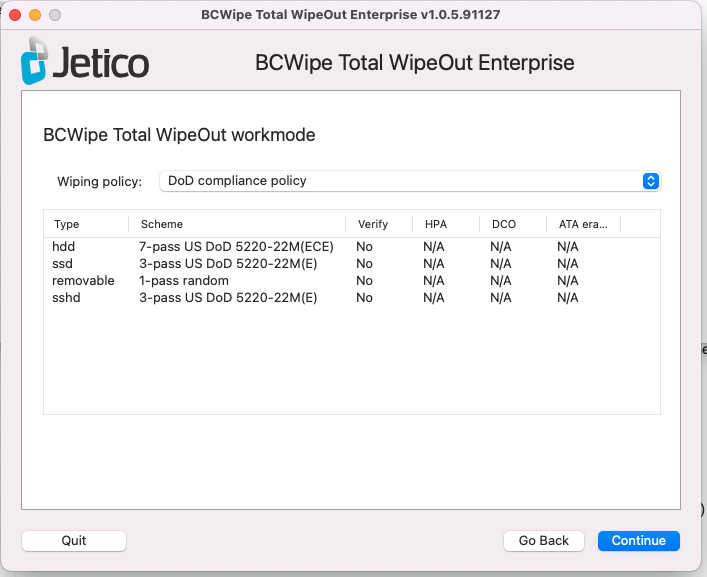Mac: Creating a bootable USB
IMPORTANT: In order for BCWipe Total WipeOut Wiping Utility to run correctly on the target Mac, BCWipe Total WipeOut Configuration Wizard must be run on a mac with the same hardware as the target device. In other words:
- To erase a T2 Mac, download and run BCWipe Total WipeOut Configuration Wizard on a Mac with the T2 chip.
- To erase an M1 Mac, download and run BCWipe Total WipeOut Configuration Wizard on a Mac with M1.
Click "BOOTABLE USB" next to Intel Mac (2018+) and ARM64 Mac (2020+) at the Wipe a device block at the General page. This will download the dmg file containing the BCWipe Total WipeOut Configuration Wizard app for Mac. Open the file and run “BCWipe TWO Enterprise”.
|
1. Launch BCWipe Total WipeOut Configuration Wizard
Click "BOOTABLE USB" next to Intel Mac (2018+) and ARM64 Mac (2020+) at the Wipe a device block at the General page. This will download the .dmg file containing the BCWipe Total WipeOut Configuration Wizard app for Mac. Open the file and run “BCWipe TWO Enterprise”. |
|
|
2. Select target Mac type Plug in the USB drive you will be using with BCWipe Total WipeOut. Select the USB from the list of drives. Now under Target system choose the type of processor for your target computer – Intel / T2 or ARM / M1 - and click Continue. |
|
|
3. Choose connection type If the target device has wired connection to the local network, we recommend choosing the "Online mode only" option. This enables the capabilities of remote management. All the data associated with the wiping task including the license count will be sent to the web console in real time. If it's unclear whether the target device has wired connection or not, choose "Allow offline if online is unavailable". This option allows for greater flexibility. If the device does have connection to the server, you can still enjoy the remote management capabilities. Otherwise, the wiping process shall be controlled locally at the endpoint. To enable wiping in offline mode, pre-load some wipes to the USB. To do so, adjust the amount in the "Wipes on USB" edit box to match the expected number of drives to be wiped offline. NOTE: If BCWipe Total WipeOut Server IP is not accessible from the computer you're running the configuration wizard on, the USB can only be created for "Online mode only" Click Continue to proceed to the next step of the Configuration Wizard. |
|
|
4. Choose mode of operation When in Automatic mode, BCWipe Total WipeOut will erase all drives connected to the target endpoint after a 1 minute countdown. When in Manual mode, a user selects drives to be wiped and initiates the wiping process manually. |
|
|
5. Select wiping policy The Wiping policy drop-down menu loads the list of wiping policies created in the web console. The Default policy features the wiping settings carefully selected by Jetico engineers to ensure the most effective results with minimal lifetime impact on each of the the drive types. In this tutorial we will choose the Default Policy. Learn how to create a custom wiping policy here: Policy Management With the demo license all wiping schemes are reset to the 1-pass-zero scheme. Purchase a full license to unlock the jetico-recommended schemes in Default policy. |
|
|
6. Finish creating the USB Review the selected settings at the Overview page of the Configuration Wizard, then click Create to initiate the bootable USB creation process. Once the bootable USB is ready, you will see a confirmation window. Click Finish. |
|
|
7. Boot target Mac with BCWipe Total WipeOut In Recovery mode, select the “macOS base system” entry with BCWipe's icon. BCWipe Total WipeOut wiping utility UI will start up. |
|







